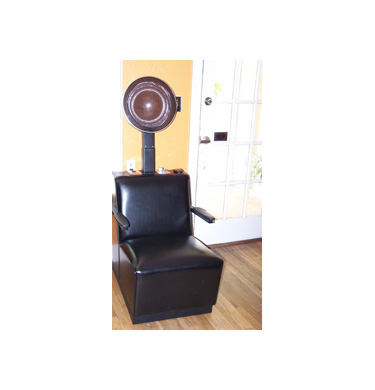


There was a time in Black American hair history when someone with a cosmetological soul decided the final barrier to racial equality should be toppled—the curly perm. Given the recalcitrant nature of black hair, a simple tight roll set was not going to be sufficient so this enterprising individual, the one with the comsetological soul, developed the Jheri Curl, also known as the Carefree Curl, a sassy and curly wet look for black men and women everywhere, made possible by a complex and probably dangerous combination of chemicals that would force black hair into a loose curl and keep it that way for up to three months at a time provided the recipient of the Jheri Curl adhered to a strict and expensive maintenance regimen. Much like modern pharmacology, the Jheri Curl espoused the capitalistic ideal that profit is never in the cure but rather the medicine. Not only did beauticians make money on the application of the perm itself, they (and the manufacturer, of course) made a killing selling the products required to maintain the hairstyle. This enterprising cosmetological, capitalist soul was a man and his name was Jheri Redding. He was white. His race is neither here nor there but it is an interesting piece of trivia you can now share at a cocktail party or job interview. You’re welcome.
I received my first and only Jheri Curl in 1989, some time after the height of its popularity, my sophomore year of high school. I was at boarding school in New Hampshire and needed a hairstyle that would keep my hair looking respectable between visits home for the major holidays. That’s what I told my parents. Really, I wanted my hair to look like Michael Jackson’s in Thriller, so curly and bouncy and luxurious. This was, of course, before the Pepsi video fire a year after that video was released, and the altered skin pigmentation situation that would soon follow, when Jackson was quite foxy. That’s what we called an attractive man back then. Or that’s what I called an attractive man back then. I was very cool.
I took the Peter Pan bus to Boston with a worldlier black friend, my first ever, and we ventured to Roxbury where we heard all the black people lived. We deduced that where black people lived, black people got their hair did and we were right. After some stumbling around, we happened upon a busy salon in a neighborhood where we felt confident our chances of not getting killed were high. There were stories, you see, about that part of Boston and we were too far removed from the city to know those stories were ridiculous. My friend was only getting a relaxer, blow dry and curl. I should have taken her cue but I had it in my head I was going to get a Jheri Curl, sticking with my tradition of adopting current styles well beyond their currency.
Four very long, frustrating hours later, during an ordeal that involved a lot of waiting while the beauticians ate lunch from sweaty Styrofoam containers, gossiped and otherwise avoided working; enduring the application of chemicals that smelled terrible and felt even worse on my tender scalp; and abiding tiny hard plastic rollers being practically welded to my head; my hair was transformed from a Kid N Play high top fade (I have no idea what prompted that style choice seeing as I was a girl but it was the 80s and we all made questionable style decisions) to a head of dark, greasy curls clinging to my face and neck uncomfortably. My mother once told me women have to suffer to be beautiful after I complained about how much I hated going to the beauty salon. If you would like to get a Jheri Curl for some reason, if you feel that inexplicable urge to put a wet perm in your hair, know this: you will suffer and you will not necessarily find yourself rewarded with beauty as recompense for your suffering.
My stylist, a Dominican woman who was not gentle with a comb and who kept squeezing me against her warm, ample, cinnamon-scented bosoms as she styled my hair, gave me a set of complex instructions for the care and feeding of my new hairdo and conveniently, was able to sell me the necessary products to maintain my Jheri Curl (an activator and a moisturizer) for a mere 200% of their retail value because nothing screams sucker like a black girl from Nebraska wearing boat shoes and a plaid jumper. I caught my reflection as I left the salon more than $150 poorer and tried to ignore my disappointment. I had a bowl hairstyle, only curly. It was karmic retribution for all the bowl haircut jokes I had made since the second grade. As I rode the Peter Pan bus back to school, I played with my hair incessantly, ignoring the greasy residue left on my fingers. There was such bounce to my curls. When I turned my head from side to side, the curls swayed gently. As I disembarked from the bus, I did the Thriller zombie walk, ignoring the grapefruit sized grease stain I left behind on my seat. I could live with the bowl because it had bounce.
That night, after I got my first perm, I applied the necessary, overpriced moisturizer to my hair with a spray bottle and ran my fingers through my curls. It was the beginning of a months-long period of time when my fingers were perpetually coated in hair product. Should you feel follicularly nostalgic and want to revisit the Jheri Curl as a hairstyle option, know this: your hands, forehead, and neck will never feel clean again. I still suffer from flashbacks. Cloth furniture will remember you, or at least, the greasy imprint of the back of your head. You will forever mark the path behind you with grease spots of varying sizes. You will ruin your clothing and bedding. You will have no secrets. Your way will be known. I covered my head in a plastic shower cap as instructed, and therein I realized that the Jheri Curl was not really the right hairdo for a girl with little interest in doing her hair. All night I had to listen to the crunchy sound of the plastic cap sliding against the pillow and my carefree curls. Know this: the Jheri Curl is not for the well rested. It was impossible to sleep with the elastic band of the cap digging into my forehead. In the morning, exhausted and my head throbbing as I brushed my teeth, I noticed a deep indentation a few millimeters wide along the entirety of my hairline and so in class I sported not only a new, increasingly outdated hairdo but a new facial decoration. I applied the activator I was supposed to use once a day, and used a pick to apply some fluff to my hair. I told myself the bowl had bounce a few times to psyche myself up to leave the dorm. I was determined to be as carefree as my curls. My confidence lasted approximately seven minutes until I ran into a group of black classmates (out of a thousand students, there were only 48 of us so there was a certain tolerance among us). They laughed at my hairdo and quickly pointed out all the things I was worried about—the bowl, the lack of social currency, the dripping moisturizer. Know this: the Jheri Curl will curry no favors among your peers.
The busty Dominican warned me to never let my hair dry or I would ruin my expensive Jheri Curl. I took her warning seriously because I knew my parents would not take kindly to my not properly maintaining the very expensive hairstyle I had so passionately lobbied for over the previous months. Throughout that first day I went through an entire bottle of moisturizer, a bottle that should have lasted three to four weeks, giving my curls a quick spritz approximately every thirty-three minutes. I was terrified my hair would dry out and I would ruin my new look, leaving me not only with a bowl cut but a dry and frizzy one. Whether I was in class or doing PE or eating in the dining hall, I whipped out my spray bottle and handled my hair business. Not only did I moisturize constantly, I did so liberally. I was not afraid to depress the pump on that moisturizer bottle. The Jheri Curl is truly not a practical hairstyle, especially not for a fifteen year old lacking in common sense.
I grew bored with the activation/moisturizing routine in about a week. I grew intensely irritated with the mess my hair made a week after that. My boyfriend expressed a great deal of displeasure about his inability to run his fingers through my hair without collecting a liberal amount of product. The Jheri Curl began to feel like a burden but I couldn’t admit defeat because that would give my parents the satisfaction of saying, “We told you so.” If I admitted defeat I would have had to accept that perhaps I did not know everything. I am still unwilling to capitulate on this point. I spent all my free time spraying my hair with chemicals that probably depleted me of precious brain cells, and trying to force the bouncy bowl into a more contemporary look. I failed. I failed miserably. My forehead, perpetually coated in grease, became dotted with ugly pimples. Know this: the Jheri Curl is not kind to clear skin. It was an ugly time. After four months, when I surrendered, I learned I would have to wait for the perm to grow out before I could do something different with my hair. It was… a final insult. Like most black women, I was trying to make my hair good according to an arbitrary standard set by a white man who clearly did not have a black woman’s best interests at heart. It was a familiar routine.
My Haitian mother began taking me to the beauty shop to get my hair relaxed starting when I was five years old. We lived in West Omaha, better known as White Omaha and she had to drive me clear across town to North Omaha where “the Black Americans lived.” My mother had thick, straight hair so long she could sit on it when I was a child. She had good hair and no idea how to deal with my not so good hair. The first time we went to North Omaha, I stared at the rundown buildings with bars on the windows and faded paint. It was a world vastly different from the neighborhood where every house looked the same and every family looked the same but mine. As the stylist led me to her chair, my mother pointed to my head helplessly and said, “I don’t know what to do with her hair,” and the stylist said, “We’ll get her hair good.” That was the beginning of a lifelong slavery to my hair that most black women are familiar with—spending Saturday afternoons in crowded, hot beauty salons, waiting for hours, enduring chemical relaxers, hot combs and curling irons burning your ears, sitting drowsily beneath hot dryers with your head rolled tightly, spending exorbitant amounts of money without quite knowing why but resenting it nonetheless and then spending the next week avoiding water, sleeping with your head propped up awkwardly and walking around with a perpetual headache. Intellectually I know there’s no such thing as good hair versus bad hair and that the beauty industry has done a remarkable job of convincing black women they want to be slaves to their hair. It is difficult to be rational about hair. My hair is on my head, always with me, always forgiving me for the chemicals and processes I put it through, managing to look awesome when I need it to. My hair is damn good to me even though I am rarely good to my hair.
A Jheri Curl accounting:
Money spent over four months to maintain my Jheri Curl: $720
Bottles of moisturizer used: 47
Bottles of moisturizer a person properly maintaining their Jheri Curl would have used: 4
Bottles of activator used: 9
Bottles of activator a person properly maintaining their Jheri Curl would have used: 3
Pillowcases ruined: 5 (my entire supply)
Bed sheets ruined: 5 (see above)
Towels ruined: 6 (see above)
Outfits ruined: 11 (see above)
Relationships broken: 1 (see above)
Know this: the Jheri Curl ruins everything.

